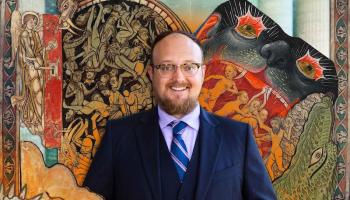Award-Winning Book Explores the Tragic History of the Collapse of the Freedman’s Bank

When the Freedman's Saving and Trust Company collapsed in 1874, just nine years after it was chartered by the U.S. Congress, it took with it the hopes, the dreams and the life savings of over 60,000 former slaves who saw the bank as a means to economic freedom and self-determination.
In Justene Hill Edwards’ latest book, Savings and Trust: The Rise and Betrayal of the Freedman's Bank, the University of Virginia historian offers a comprehensive look at the history of the Freedman's Bank, from the hopes on which it was founded to the financial mismanagement that brought it down. Introducing new archival evidence, Edwards argues that fraud committed by the bank's white financiers drove the institution into the ground and that the repercussions of that tragedy continue to shape the American economic landscape today.
Savings and Trust has already earned Edwards the Business History Conference’s Harold F. Williamson Prize — awarded to a scholar who has made significant contributions to the field of business history. It was also a finalist for the Hagley Prize for the best book in business history, and it has been nominated for the Columbia Journalism School’s Mark Lynton History Prize .
Read an excerpt from the book The New York Times calls "a riveting and heartbreaking read," and what Pulitzer Prize-winning author Marcia Chatelain calls "an essential read for anyone concerned about racial and economic justice."
From Savings and Trust: The Rise and Betrayal of the Freedman's Bank
If you’ve ever visited the National Mall in Washington, DC, and stood in front of the White House at Sixteenth Street and Pennsylvania Avenue, you’ve probably strolled past the site where the Freedman’s Savings and Trust Company’s central office once stood. Positioned adjacent to the White House and the Department of the Treasury on 1509 Pennsylvania Avenue, in the southeast corner of Lafayette Square, the bank’s main office from 1871 to 1874 stood mere steps from the seats of executive and financial power during Reconstruction. Today, on the corner of Madison Place and Pennsylvania Avenue NW, in the heart of the nation’s capital, stands a plaque that commemorates the Freedman’s Savings and Trust Company, also known as the Freedman’s Bank. The inscription on the plaque reads:
On this site stood the principal office of the Freedman’s Savings
and Trust Company founded on March 3, 1865 to receive deposits
from former slaves. Frederick Douglass served as its last president.
The bank was closed on June 29, 1874. The building was sold in
1882, and razed a few years later.
These four short lines are all that remain to honor one of the most profound, and tragic, stories in American history.
Hopefully, the plaque piques your interest. Unfortunately, it doesn’t fully capture the bank’s story. While it’s true that the bank was established on March 3, 1865, to “receive deposits from former slaves,” the bank did much more. Its administrators also made loans, allowing white people with connections to the bank’s trustees to borrow Black depositors’ money. Black depositors, however, were barred from borrowing money from the very institution into which they were funneling millions of dollars.
And there’s more. Though Frederick Douglass did serve as the bank’s last president, the trustees, most of whom were white, appointed Douglass knowing that it was on the verge of complete collapse, which occurred three months after he accepted the position.
Furthermore, the bank did not simply close. After the trustees voted on June 29 and again on July 1, 1874, to cease operations, the bank officially suspended payments to depositors on July 2, 1874. Bank administrators had loaned out so much of Black depositors’ money to white borrowers that African Americans who wanted to make withdrawals could not access their hard-earned funds. The administrators operated the bank with such malfeasance, lending money without collateral and at times stealing deposits, that members of Congress called for the bank’s closure to fully account for the wrongdoing.
At its height, freed people had opened over one hundred thousand accounts and deposited over $57 million ($1.5 billion today). When the bank closed, it left the remaining 61,144 depositors without access to the almost $3 million still left in bank accounts. After it ceased operations, depositors and their descendants spent decades, into the 1930s and 1940s, pleading with members of Congress, attorneys general, and even U.S. presidents to help them recoup their money—to no avail. Given the bank’s heartrending history, it is surprising that a plaque is all that remains to commemorate the Freedman’s Savings and Trust Company.
After reading the plaque, one might ask: What happened to the depositors after the bank failed? Savings and Trust seeks to answer this question—and many more. It tells the history of the bank’s rise and of the Black Americans who helped make the bank a success. It also tells a story of betrayal and theft. This book shows how a group of white Americans gambled with, plundered, and stole from Black people as they climbed out of slavery into a new era of freedom. It establishes how people at the highest levels of finance and government pillaged a bank filled with African Americans’ money and destroyed the economic foundations on which recently freed people were building their lives. Ultimately, Savings and Trust shows that one of the origins of America’s racial wealth gap can be found in the failure of the Freedman’s Bank in 1874.
Excerpted from Savings and Trust: The Rise and Betrayal of the Freedman's Bank. Copyright © 2024 by Justene Hill Edwards. Used with permission of the publisher, W. W. Norton & Company, Inc. All rights reserved.








